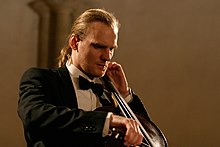Music stand

A music stand is a device that holds sheet music in a position that allows the performer to read it while performing.
There are various types of music stands. There are ornate wooden ones that tend to be pricey, there are digital ones with automated page turning, and the most popular ones, the metal ones that can be folded for ease of transportation. There are also small ones that can be attached to the instrument itself, as in marching bands. Thomas Jefferson, former president of the United States, invented a revolving music stand which he never patented because he liked for people to freely use his inventions.
The term “stand,” as it is used to describe furniture such as a plant stand or music stand, generally implies a relatively small surface area supported at the required height, most usually by a turned leg or support known as a “standard.”
Despite this basic definition, by the middle of the 18th century, many stands had developed into more elaborate constructions fitted with various open shelves, drawers, and other compartments for the display of various items such as plate and china.
Stands may be designed for tabletop use or may be tall enough to stand alone, sometimes, as in the case of music stands, being adjustable in this respect. Typically designed for a specific function, stands are invariably so qualified and described. Among the most common are candlestands, hall stands, music stands, china, flower, lamp, plate, and even wig stands.
All the above-mentioned stands are designed and used for specific items; stands designed to support other pieces of furniture are generally subservient to the particular piece and are not generally regarded as separate objects. For example, the stand on which a desk box might rest is seldom thought of as a separate object, the entire piece generally being thought of as a “desk box on stand.”
Nevertheless, the distinction becomes fuzzy with certain pieces when the stand is no longer a separate construction but rather an integral part of the piece in question, as, for example, a speaker’s desk or a lectern.
Any inclined surface that can be used for supporting music may be thought of a music stand, although generally this function is divided between two types of furniture: a music stand proper and a music desk.
The music stand, as the name suggests, consists of a support for the music raised upon a freestanding column or tripod, which, in addition to being movable may also be adjustable with regard to its height and the angle at which it may be tilted.
A music desk generally implies a similar, tiltable support for the music, but rather than being raised on a stand, instead forms part of a table. In as much as the term ‘desk’ originally implied a sloping-topped table for reading or writing, the slight adjustment necessary to turn a desk into a music desk, perhaps merely by enlarging the size of the support for the manuscript, was a relatively simple matter.
There are also digital music stands, which allow page turns to be made with a pedal or those with lights known as the opera stand
